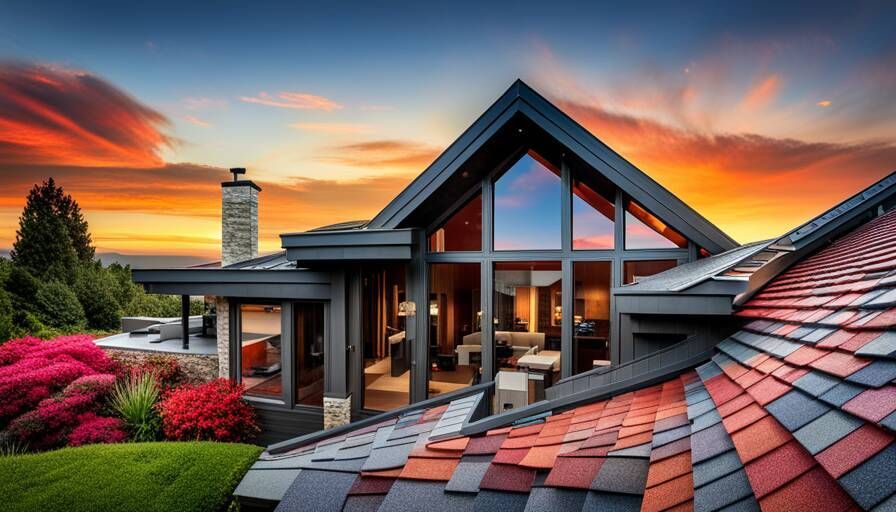Impact of Shingle Color on Home’s Appearance
The color of shingles on a home’s roof can have a significant impact on its overall appearance. When choosing the right shingle color, it’s essential to consider factors such as architectural style, neighborhood aesthetics, and personal preferences. The color of the shingles can either harmonize with the rest of the exterior or provide contrast to create visual interest. It has the potential to enhance curb appeal and contribute to the overall aesthetic appeal of the property.
For instance, dark-colored shingles can convey a sense of sophistication and elegance, especially when paired with lighter-colored exteriors. On the other hand, lighter-colored shingles can create a more vibrant and welcoming look, particularly for homes with darker exteriors. The choice of shingle color can also affect how light is reflected or absorbed by the roof, potentially influencing energy efficiency.
Now that we understand how shingle color impacts a home’s appearance let’s explore some strategies for maximizing curb appeal through careful selection and application of shingle colors.
- According to research published in Science Direct, lighter-colored shingles can help reduce heat gain by up to 20% compared to darker ones.
- The National Association of Home Builders states that a white roof can reflect 65% of sunlight, keeping the surface 23% cooler than that of a standard dark roof.
A study from the Lawerence Berkeley National Laboratory found that switching to a cool roof that reflectsmore sunlight off the building could save up to 50% in cooling effort during summer months.
Maximizing Curb Appeal
Curb appeal plays a crucial role in creating an attractive and welcoming first impression for your home. The selection of shingle colors is just one element that contributes to maximizing curb appeal. Here are some key considerations:
- Architectural Style: Take into account the architectural style and design elements of your home. Traditional styles may be complemented by neutral or earth-tone shingles, while contemporary designs might benefit from bolder color choices.
- Neighborhood Aesthetics: Consider the surrounding houses in your neighborhood to ensure your choice
aligns with the area’s general aesthetic. Striking a balance between individuality and fitting into the neighborhood can help maintain property value.
- Climate Considerations: Different regions experience varying climate conditions, which can impact the
longevity and functionality of your roof. Light-colored shingles reflect more sunlight and can help keep the interior cooler in hot climates, while dark-colored shingles absorb more heat and might be beneficial in colder regions.
- Color Psychology: Colors evoke emotions and create certain perceptions. Consider the mood you want to
convey with your home’s exterior. For example, warm tones like red or brown can give a sense of coziness, while cool tones like blue or gray can create a calm and serene ambiance.
Selecting the right shingle color to maximize curb appeal is like choosing the perfect accessories to complement an outfit. Just as well-selected accessories can elevate an ensemble, carefully chosen shingle colors have the potential to enhance your home’s overall aesthetic appeal.
These considerations are important starting points for selecting shingle colors that will enhance your home’s curb appeal. By paying attention to these details, you can create a visually appealing exterior that reflects your personal style while harmonizing with the surrounding environment.
Trends in Shingle Colors
When it comes to choosing the right shingle color for your roof, trends play a significant role. The colors you select can make a statement and enhance the overall curb appeal of your home. While classic shades such as neutral grays and earth tones have long been popular, recent trends have seen homeowners exploring bolder options. Vibrant blues, deep reds, and even shades of green are becoming more prevalent, adding personality and uniqueness to homes. It’s essential to consider these trends when making your decision to ensure your home stands out in the neighborhood.
Role of Shingle Color in Home Efficiency
The color of your shingles not only affects the aesthetic appeal of your home but also plays a role in its energy efficiency. Darker colored shingles tend to absorb more heat from the sun, which can increase the temperature inside your home. This is particularly important in warmer climates where cooling costs can be a significant expense. On the other hand, lighter colored shingles reflect more sunlight and help keep your home cooler. By selecting a lighter color, you can potentially reduce your energy consumption and lower your utility bills.
For instance, imagine living in a region with scorching summers where air conditioning is a necessity. Choosing light-colored shingles could contribute to keeping your home cooler and reduce the strain on your cooling system.
However, it’s important to note that the impact of shingle color on energy efficiency may vary depending on various factors such as insulation, ventilation, and regional climate conditions. Consulting with roofing professionals or considering energy-efficient materials may provide additional insights into maximizing the efficiency of your home.
Shingle Color and Heat Absorption
When it comes to shingle color, one important factor to consider is its impact on heat absorption. Darker-colored shingles tend to absorb more heat from the sun, which can result in higher attic temperatures. This excess heat can affect the overall energy efficiency of your home and potentially increase cooling costs during hot summer months. In contrast, lighter-colored shingles reflect more sunlight and help keep the attic cooler. However, it’s worth noting that other factors such as insulation and ventilation also play a significant role in controlling heat levels within your home.
Factors to Consider in Shingle Color Choice
Choosing the right shingle color for your home goes beyond personal preference; it can have a noticeable impact on curb appeal. Here are some key factors to consider when making your decision:
- Architectural Style: The architectural style of your home can influence the suitability of different shingle colors. For example, traditional styles may look great with neutral colors like gray or brown, while more modern designs might benefit from bold and vibrant options.
- Climate: Consider the climate in your area when selecting shingle colors. In warmer regions, lighter-colored
shingles can help reflect sunlight and keep the home cooler, whereas darker colors may provide additional warmth in colder climates.
- Neighborhood Aesthetics: Take into account the overall aesthetics of your neighborhood. While you want
your home to stand out, choosing a shingle color that complements or harmonizes with neighboring houses can create a unified and appealing streetscape.
- Resale Value: If you’re thinking about selling your home in the future, consider how different shingle colors
might affect its marketability. Neutral colors tend to have broader appeal and may attract more potential buyers compared to unconventional or overly bold choices.
Remember that visualizing how a particular shingle color will look on your roof can be challenging. Requesting samples from manufacturers or using online visualizers can help you get a better idea of how the color will appear once installed.
Now that we’ve discussed the factors to consider in shingle color choice, let’s explore the versatility and options available when it comes to different shingle colors.
Versatility and Options in Shingle Colors
When it comes to boosting curb appeal, shingle color plays a significant role in the overall aesthetic of a house. The great news is that there is an abundance of versatility and options available when it comes to selecting shingle colors. Whether you prefer classic and timeless neutral tones like gray or brown, or you want to make a bold statement with vibrant reds or blues, the choices are virtually endless.
Imagine a charming colonial-style home with a pristine white exterior. Now, picture how different it would look with dark gray shingles compared to warm-toned brown shingles. The color of the roof can completely transform the appearance of the house, giving it a modern or traditional touch depending on the chosen shade.
“I always thought that roof color didn’t matter much until I painted mine. The difference it made was astonishing! It went from looking dull and ordinary to becoming the envy of the neighborhood.” – John, homeowner
The versatility of shingle colors allows homeowners to express their personal style and make their homes stand out in a sea of houses. Are you aiming for a sleek and contemporary look? Consider opting for slate gray or charcoal black shingles. Want to evoke a cozy and rustic feel? Earthy tones like terracotta or forest green can do just that.
Similar to choosing paint colors for your walls, selecting the right shingle color brings out the personality of your home’s exterior. Just as a pop of vibrant color can liven up a room indoors, vibrant red or blue shingles can add character and charm to your home’s exterior.
Moreover, different regions might have varying preferences when it comes to shingle colors. In coastal areas, lighter shades are often chosen to reflect heat from the sun and maintain cooler interiors. In colder regions, darker hues may be favored to absorb heat and assist with snowmelt.
With the numerous options available, finding the perfect shingle color can be an enjoyable process that allows you to personalize your home’s appearance. Now that we’ve explored the versatility and options in shingle colors, let’s dive deeper into how certain colors can impact curb appeal in specific ways.


